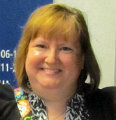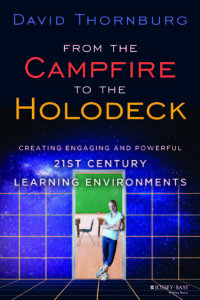Engaging Students by Shifting the Environment
From the Campfire to the Holodeck: Creating Engaging and Powerful 21st Century Learning Environments
By David Thornburg
(Jossey-Bass, 2014 – Learn more)

Being a fan of science fiction/fantasy, I found the title of this book intriguing. From the Campfire to the Holodeck was written in a very understandable manner, and it readily grabs the reader’s attention.
The book begins by explaining the engagement problems in traditional classrooms, and it spoke to my teacher’s heart. Too many classrooms are designed with the “eyes-front” rule with the desks all in rows. Traditional school design encourages this, Thornburg says, and “the time is long overdue to shift the blame for a failed system from the teachers to the facilities themselves.” We need classrooms and strategies that open the doors for the widespread adoption of inquiry-driven, project-based learning.

Campfires brought to the forefront the century-old dominance of lecture in classrooms around the world even though not all students learn effectively this way. To augment lecturing, the author suggests having short videos/demonstrations with just enough background information to set the stage for the inquiry question. Students then respond by doing research and creating projects to show what they have learned.
Lectures have validity, but Thornburg’s approach allows a more 21st century approach. Short, pithy backgrounders are followed by inquiry, pushing our students to think for themselves and to learn by integrating what they’ve heard with what they’re doing and investigating.
Learning out loud in open spaces
Thornburg’s discussion of watering holes points out what really should have been obvious: the reason the students are so loud and boisterous in the lunchrooms and hallways is because they have been given so little opportunity in their schools for conversation. Humans learn from each other, from sharing questions and answers. Talking in groups helps us to complete thoughts and put together questions, which allows for dialogue to take place around a common theme.
The author’s discussion of effective learning environments is compelling. If only we could create school facilities that eliminate permanent walls and design our rooms as we need them for each class, as the author suggests. The books continues to take us through the author’s journey bringing us to technological campfires, technological watering holes, technological caves and ultimately – technological life spaces.
Thicker learning
One of my favorite quotes from the book comes from page 56: “When students are researching topics on their own, there is a huge opportunity for them to develop passion for the subject area – a passion that does not appear in traditional textbook approaches to instruction.”
As they integrate the technologies that Thornburg recommends into the classroom, teachers need to consider how best to help students learn to choose the questions that get explored: “thick questions,” as we call them at my school, not thin (questions answered in a simple yes or no, with no need for explanations).
Thornburg reminds us that the teacher’s role is to be a collaborator while the students use social networking tools. Noting that technology allows us to “transcend space and time,” he shares and examines technological activities.
The later chapters encourage us to think about how we and our school are using technology to support what is happening in our classrooms. Are we merely lecturing and reaching just a few of our students? Or are we opening doors to new ways to explore, to learn and develop our learning, and to advance our students in this technological age? Reading this book will stimulate your thinking about what the ideal classroom should be and could be as technology improves and we get closer to teaching on a real holodeck.
Andrea Long is a 6th grade Science teacher currently in her 23rd year of teaching middle school in Iowa. She has been a mentor to other teachers. In 1995 Andrea taught and participated in NASA’s space camp for high school students. She has a BA with an Art major and a Biology minor, and a MA in Elementary Education with a specialization in Reading.





























